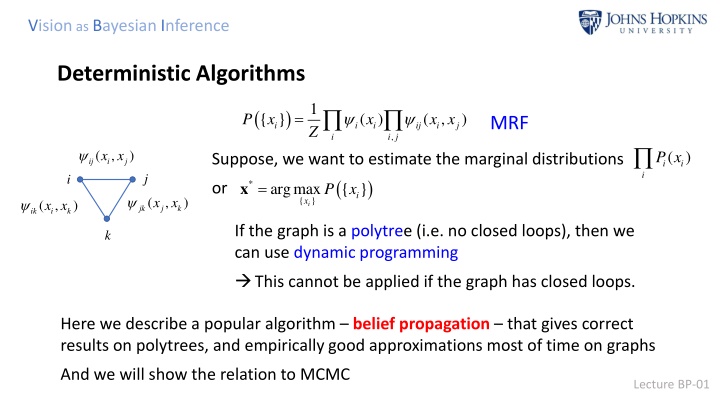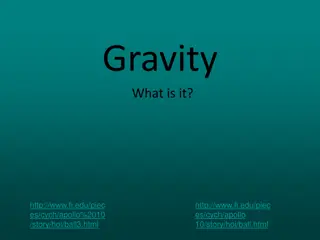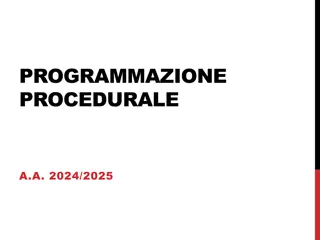
Vision as Bayesian Inference and Belief Propagation
Explore how belief propagation plays a crucial role in Bayesian inference for vision processing, utilizing algorithms like sum-product and max-product to approximate marginals in graph structures. Discover the applications and historical context behind these methodologies.
Download Presentation

Please find below an Image/Link to download the presentation.
The content on the website is provided AS IS for your information and personal use only. It may not be sold, licensed, or shared on other websites without obtaining consent from the author. If you encounter any issues during the download, it is possible that the publisher has removed the file from their server.
You are allowed to download the files provided on this website for personal or commercial use, subject to the condition that they are used lawfully. All files are the property of their respective owners.
The content on the website is provided AS IS for your information and personal use only. It may not be sold, licensed, or shared on other websites without obtaining consent from the author.
E N D
Presentation Transcript
Vision as Bayesian Inference Deterministic Algorithms 1 Z = ( ) { } x ( ) x ( , x x ) P MRF i i i ij i j , i i j ( , x x ) ( ) P x Suppose, we want to estimate the marginal distributions ( ) { } i x ij i j i i i j i = * x argmax { } x P or i ( , ) x x ( , x x ) jk j k ik i k If the graph is a polytree (i.e. no closed loops), then we can use dynamic programming This cannot be applied if the graph has closed loops. k Here we describe a popular algorithm belief propagation that gives correct results on polytrees, and empirically good approximations most of time on graphs And we will show the relation to MCMC Lecture BP-01
Vision as Bayesian Inference Belief Propagation (BP) proceeds by passing messages between the graph nodes :message that node i passes to node j to affect state xj ( : ) t m x ij j The messages gets updated as follows: = + ) ( : 1) ( , x x ( ) x ( : ) m x t m x t Sum-product rule ij j ij i j i i ki i x k j i Alternative: the max-product + = ) ( : 1) max x ( , x x ( ) x ( : ) m x t m x t ij j ij i j i i ki i i k j If the algorithm converges (it may not), then we compute approximations to the marginals: ( ) ( ) ( ) i i i i ki i k ( , ) ( ) ( , ij i j i i ij i b x x x x x b x x m x ) ( ) ( ) x ( ) x m m x j j j ki i lj j Lecture BP-02 l i k j
Vision as Bayesian Inference Belief Propagation BP (sum-product) was first proposed by Judea Pearl (C.S. UCLA) for performing inference on polytrees The max-product algorithm was proposed earlier by Gallagher The application was developed in the 1990 s for decoding problems - goal was to achieve Shannon s bound on information transmission Experimentally, it was shown that BP usually converges to reasonable approximations - Full understanding of when & why it converges is an open problem On polytree, it is similar to dynamic programming so in a sense, it is the way to extend DP to graphs with closed loops Lecture BP-03
Vision as Bayesian Inference Example of BP (sum-product) = x ( , x x x x , , ) 1 2 3 4 1 2 3 4 1 Z = ) ) ( ) x ( , x x ( , x x ( , x x ) P 12 1 2 23 2 3 34 3 4 Messages: Update rule (from message passing equation) = ( : 1) ( , ) x m x t x x m ( : 1) ( , x m x t x x m ( : 1) ( , x m x t x x m ( : 1) ( , x m x t x x m ( : 1) ( , x m x t x x + boundary m12(x2), from node 1 to node 2 m21(x1), from node 2 to node 1 m23(x3), from node 2 to node 3 m32(x2), from node 3 to node 2 m34(x4), from node 3 to node 4 m43(x3), from node 4 to node 3 ( : 1) ( , x x ) m x t 12 2 12 1 2 x 1 = = = = = + ( : ) t x 21 1 12 1 2 32 2 2 + ) ( : ) t x 23 3 23 2 3 12 2 2 + ) ( : ) t x 32 2 23 2 3 43 3 3 + ) ( : ) x t 34 4 34 3 4 23 3 3 + boundary ) 43 3 34 3 4 Lecture BP-04 4
Vision as Bayesian Inference Many ways to run BP (1) Update all messages in parallel Note: BP can be parallelized but Dynamic Programming cannot) (2) Start at boundaries Then read off estimates of unary marginals 1 ( ) ( ), b x m x Z Z 1 ( ) ( ) ( b x m x m x Z 1 ( ) ( ) ( ), b x m x m x Z 1 ( ) ( ), b x m x Z Z 1 ( , ) ( , b x x x x m Z m12 m23 m34 i.e., = = ( ):normalization x m 1 2 3 4 1 1 21 1 1 21 1 m21 m32 m43 x 1 1 = ), :normalization Z 2 2 12 2 32 2 2 m12(x2), then m23(x3), then m34(x4) Forward pass (like Dynamic Programming) Calculate 2 = :normalization Z 3 3 23 3 43 3 3 m43(x3), then m32(x2), then m21(x1) Backward pass (like backward pass of DP) 3 = :normalization 4 4 34 4 4 4 = ) ( ), and so on x 12 1 2 12 1 2 32 2 Lecture BP-05 12
Vision as Bayesian Inference Many ways to run BP Alternatively, initialize the m s to take an initial value e.g. mij(xj)=1 for all i, j and update the messages in any order will still converge for graph with no closed loops Then estimates (beliefs) will be the true marginals = ( ) ( , P x x x x , , ) b x e.g. 1 1 1 2 3 4 , , x x x = 2 ) 3 4 ( , x x ( , P x x x x , , ) b 12 1 2 1 2 3 4 , x x 3 4 But, BP will often converge to a good approximation to the marginals for graphs which do not have closed loops This was discovered in the late 1980 s Lecture BP-06
Vision as Bayesian Inference Advantages of BP over DP (1) BP will converges (approximates) for many graphs with closed loops (2) BP is parallelizable (nice if you have a parallel computer or GPU) An alternative way to consider BP Make local approximations to the local distribution (BP w/o messages) ( b x , ) b x x 1 Z ij i j = x ( , B x ) ( ) b x ( ) i N i i i ( ) j N i ( ) i i ( b x , ) b x x ij i j = ( | ) b x x If the bij(xi, xj) & bi(xi) are the true marginal distribution, then j i ( ) i i Lecture BP-07
Vision as Bayesian Inference An alternative way to consider BP xj1 Cut the rest of the graph xjj xi xj2 ( , ) ) j b x x ( b x , ) 1 b x x jl j l = x x ( , B x x , , ) ( , ) ik i k b x x ( ) ( ) i j N i N j ij i j ( ) ( Z b x k N i l N j i ( )/ ( )/ j ij i i j Update Rule: Marginalization = xl1 xk1 + x x ( , : 1) ( , B x x , , : ) t b x x t ( ) ( ) ij i j i j N i N j xi xj xl2 xk2 x ( , ) N i j = x + x ( : 1) ( , B x : ) t b x t ( ) ij i i N i ( ) N i Provably equivalent to BP Lecture BP-08
Vision as Bayesian Inference How does this relate to MCMC? Chapman-Kolmogorov A deterministic form of Gibbs sampling = ( ) x ( | ') x x ( ') x M K (K: Transition kernel) + 1 t t x ' x = This converges to fixed point distribution (x) s.t ( | ') ( ') x x x ( ) x K ' MCMC estimates (x) by repeatedly sampling from K(x, x ) = ' N ( | ') x x ( | ) Recall that Gibbs Sampler K P x x S ( ) / , '/ x x Substituting the Gibbs sampler into the Chapman-Kolmogorov equation ( ) ( | ' t r N P + x Replace by ) t +x ( ) ( , ), i x ( , , ), i j N i j x x = x x x x ) ( ) ( ) 1 ( ) t N ( ) B x x N = 1( x y i N r i = x ( , x x ) B x x x or Lecture BP-09 ( , ) i j , i j
Vision as Bayesian Inference Bethe Free Energy It can be shown that the fixed point of BP correspond to extreme of the Bethe Free Energy ( , [ ] ( , ) ln ( ) ( i j ij x x i i j j x x ) b x x ( ) ( ) x b x ij i j = ( 1) ( )ln i b x i i F b b x x n ij i j i i ) ( , x x ) , i x ij i j i i i This leads an alternative class of algorithm which seek to directly minimize F[b] These algorithms are more complex than BP, more time consuming, and do not always give better results Note M. Wainwright defines a class of convex free energies similar to Bethe Note Junction trees allows DP to be applied to same graphs with closed loops (see Lauritzen and Spiegelhalter). Lecture BP-10
Vision as Bayesian Inference A range of alternative algorithms The original is meanfield (MFT) x ( ) ( ) x B P = = ( )ln x ( ) x ( ) ( ) b x KL B B B Kulback-Leibler: Define i i x i Seek to find the B(x) that minimizes KL(B) ( ) ( ( , ij x x ) b x b x ( ) ( ) x b x i i j j ( ) ( i b x b x )ln ( 1) ( )ln i b x i i n Equivalent to i j j i i ) ( ) x ( ) x , , i j x x i x i i i j j j i i i j i ( , ) ( ) ( i b x b x ) b x x Compare to Bethe Free Energy: ij i j i j j Minimizing KL(B) is not straightforward, but it is straightforward to find a local minima These approaches are significantly faster than MCMC, but MCMC works when these do not. Lecture BP-11






















